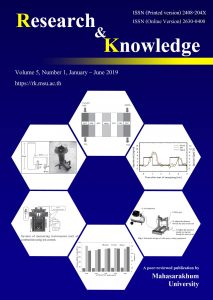An Ammonia Removal for Red Craw Crayfi sh Nursery Water Pond by using Electrocoagulation Method
Keywords:
electrocoagulation, ammonia removal, red craw crayfishAbstract
This paper propose the method of ammonia removal of red craw crayfi sh nursery water pond. The ammonia in water pond has caused from red craw crayfi sh waste which effect to baby red craw crayfi sh to have strain, anorexia, slow growth and may die. Normally, the ammonia in aquaculture water has been founded in form of unionized form (NH3 ) and ionized form (NH4 + ) which can measured by electrode sensor and transform in ammonia intensity (mg/L). The nursery pond system should be control ammonia in water less than 0.01 mg/L for safety and high growth condition. In this paper, the electrocoagulation method which based on electrochemistry principle is presented for ammonia removal. The two of aluminum electrodes are used to be an anode and cathode which receive direct current positive and negative to electrode respectively. An oxidation-reduction (redox) reaction has impact to aluminum ion separation, fl occulation, fl oatation and sedimentation with ammonia particle. The input parameter of this reaction such as types of electrodes, area of electrodes (cm2 ), voltage level (V), magnitude of current (A) and current density (A/cm2 ) are studied. The output parameters of reaction such as TDS (Total Dissolved Solid), EC (Electrical Conductivity), pH and ammonia intensity are focused. The economic aspect is concerned in term of energy cost and corrosion of aluminum material quantity. The result found that electrocoagulation method can remove ammonia intensity from from 1.8 mg/L to 0.8 in 30 minutes and 0.8 mg/L to 0.05 mg/L in 30 minutes for 10 liters reactor chamber by using energy consumption 3.75 kWh/m3 or 15 bath/m3
References
Andrea G. Capodaglio1; Petr Hlavínek2; Massimo Raboni, “Physico-chemical technologies for nitrogen removal from wastewaters: a review”, An Interdisciplinary Journal of Applied Science, vol. 10 n. 3 – Jul. / Sep. 2015.
David J Randall, T K N Tsui, “Ammonia toxicity in fish”, Marine Pollution Bulletin 45 (1-12), 17-23, 2002.
E. Bazrafshan, A. H. Mahvi, S. Nasseri, A. R. Mesdaghinia, F. Vaezi, Sh. Nazmar 2006. Removal of cadmium from industrial effluent by electrocoagulation process using iron electrodes, Iran. J. Environ. Health. Sci. Eng. 34, 261-266,
Gary L. Rogers Ammonia Removal in Selected Aquaculture Water Reuse Biofilters, Aquacultural Engineering 4 (1985) 135-154.
J. Heffron, M. Marhefke, and Brook K. Mayer (2016). Removal of trace metal contaminants from potable water by electrocoagulation, Scientific report, 6: 28478, Published online 2016 Jun 21.
J. Nepo, Hakizimana and et.al (2017). “Electrocoagulation process in water treatment: A review of electrocoagulation modeling approaches”, Desalination, Volume 404, 17 February, Pages 1–2.
K. Jo Kim, Kitae Baek, Sangwoo Ji, Youngwook Cheong, Gijae Yim, Am Jang (2016). “Study on electrocoagulation parameters (current density, pH and electrode distance) for removal of fluoride from groundwater, Environmental Earth Science, Vol 75, No. 45, pp 1-8.
N. Drouiche, S. Aoudj, M. Hecini, N. Ghaffour, H. Lounici, N. Mameri (2009). Study on the treatment of photovoltaic wastewater using electrocoagulation: Fluoride removal with aluminium electrodes —Characteristics of products, Journal of Hazardous Materials, Volume 169, Issues 1–3, 30 September, Pages 65–69.
Natan Wajsbrot, Avital Gasith, Dan M. Popper, “Acute toxicity of ammonia to juvenile seabream Sparus aurata under reduced oxygen levels”, Aquaculture 92(2-3):277-288
P. K., Holt.,Geoffrey W. Barton.and Cynthia A. Mitchell (2004). The future of electrocoagulation as a localized water treatment technology. Journal of Chemosphere, 59 (3): April 2005, 355-367.
R. Ramesh Babu, N.S. Bhadrinarayana, K.M.Meera Sheriffa Begum, Anantharaman 2007. Treatment of tannery wastewater by electrocoagulation, Journal of University Chemical Technology Metallurgy, 42 (2) (2007) 201-206.
Silapchai, Srikat, “Ammonia Nitrogen Removal from Mixed Swine and Chicken Farm Wastewater Using Manganese Zeolite in the Oxidation Ditch Model”, Environment and Natural Resources Journal, Vol.7, No.1, June 2009 52
V.K. Gupta; H. Sadegh; M. Yari; R. Shahryari Ghoshekandi; B. Maazinejad; M. Chahardori, “Removal of ammonium ions from wastewater A short review in development of efficient methods”, Global J. Environ. Sci. Manage., 1(2): 149-158, Spring 2015.
Ville Kuokkanen, Toivo Kuokkanen, Jaakko Rämö (2013). Ulla Lass, Recent Applications of Electrocoagulation in Treatment of Water and Wastewater—A Review, Green and Sustainable Chemistry, Vol.3 No.2, Article ID:31993, pages 33
Xianping Luo, Qun Yan, Chunying Wang, Caigui Luo, Nana Zhou and Chensheng Jian, Treatment of Ammonia Nitrogen Wastewater in Low Concentration by Two-Stage Ozonization, Int. J. Environ. Res. Public Health 2015, 12, 11975-11987.
Zodi S, Potier O, Lapicque F & Leclerc J (2009) Treatment of the textile wastewaters by electrocoagulation: Effect of operating parameters on the sludge settling characteristics. Separation and Purification Technol - ogy, 69(1): 29–36.
Downloads
Published
How to Cite
Issue
Section
License

This work is licensed under a Creative Commons Attribution-NoDerivatives 4.0 International License.








